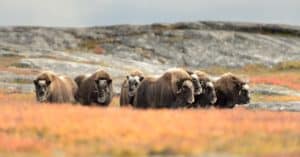The yak, or Bos grunniens, is a long-haired domesticated bovine species widely distributed across the Himalayan region of the Indian subcontinent. It can also be found in Gilgit-Baltistan, Mongolia, Northern Myanmar, Pakistan, Siberia, Sichuan, the Tibetan Plateau, and Yunnan.

You may also hear it referred to as the grunting ox or the Tartary ox. This wild ox is akin to the yak but prefers the wild (Bos mutus). In the animal kingdom, the yak is related to the cow through the genus Bos primigenius. Research into the evolution of yaks using mitochondrial DNA has yielded inconclusive results. Ready to learn more? Here are 10 incredible Yak facts!
1. They Are The Largest Native Animal In Their Range
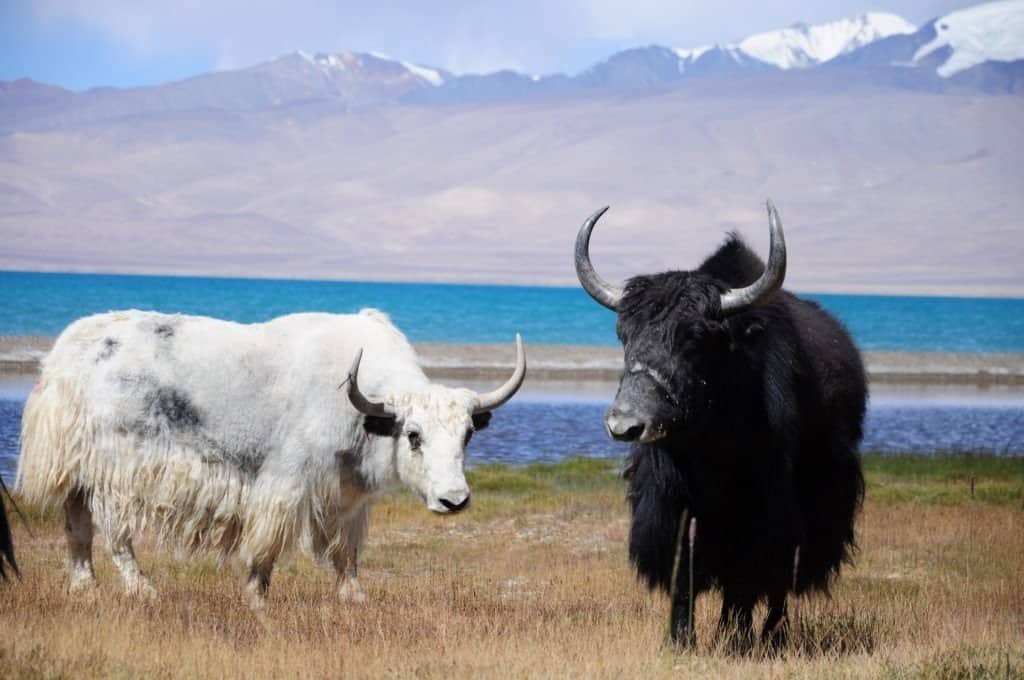
Female wild yaks are significantly smaller and weigh around a third less than male bulls.
©Olga Eromenko/Shutterstock.com
Adult wild yaks average between 5.2 and 7.2 feet in height at the shoulder and weigh between 672-2,205 pounds. The length of the body and head alone is 8.2 to 11 feet, not including the tail, which can range from 24 to 39 inches. Female wild yaks are significantly smaller and weigh around a third less than male bulls. Domesticated yaks weigh from 496 to 562 lbs. for females and 770-1,280 lbs. for males, a significant reduction from their wild ancestors.
2. Yak Calves Are Up And Walking 10 Minutes After Birth
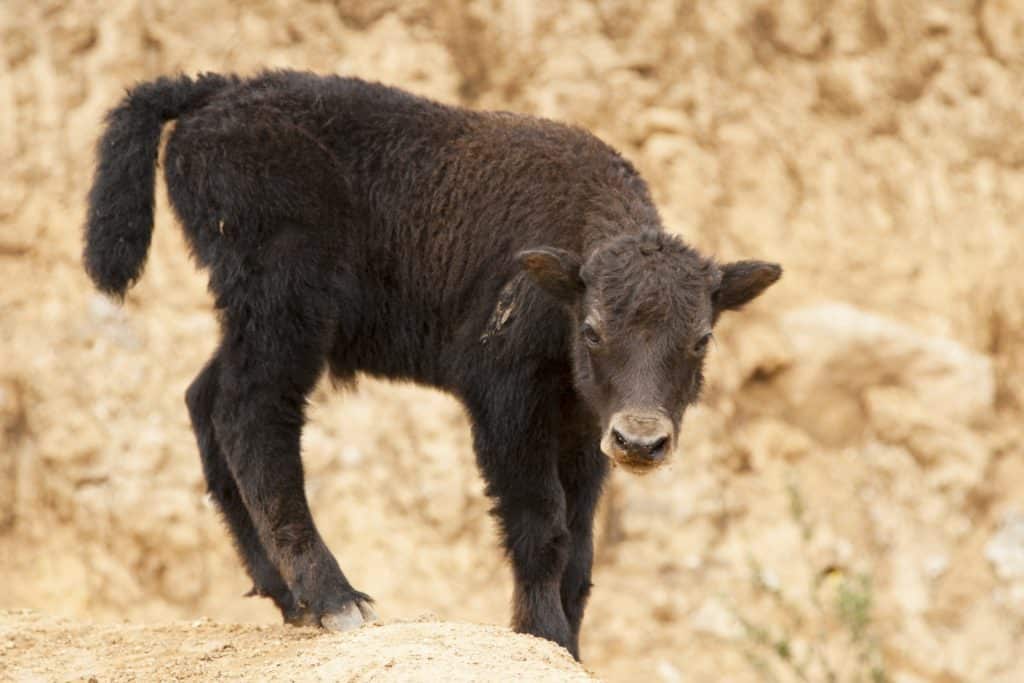
Yak calves can start walking within 10 minutes of being born
©CVancoillie/Shutterstock.com
The average female gives birth for the first time between the ages of three and four, reaching her reproductive fitness peak around the age of six. Even though more frequent births may be conceivable if the food supply is sufficient, they typically only give birth once every two years. The gestational period lasts 257 to 270 days.
Usually, the female gives birth to a single calf, which can walk within 10 minutes after being born. Twins are quite uncommon. At one year, calves are weaned, and soon after that, they are fully independent. Between the ages of 7 and 8, they are completely mature. A domesticated yak’s lifespan is typically 20 years, while it may be a little less in the wild.
3. Wild Yaks Are Endangered
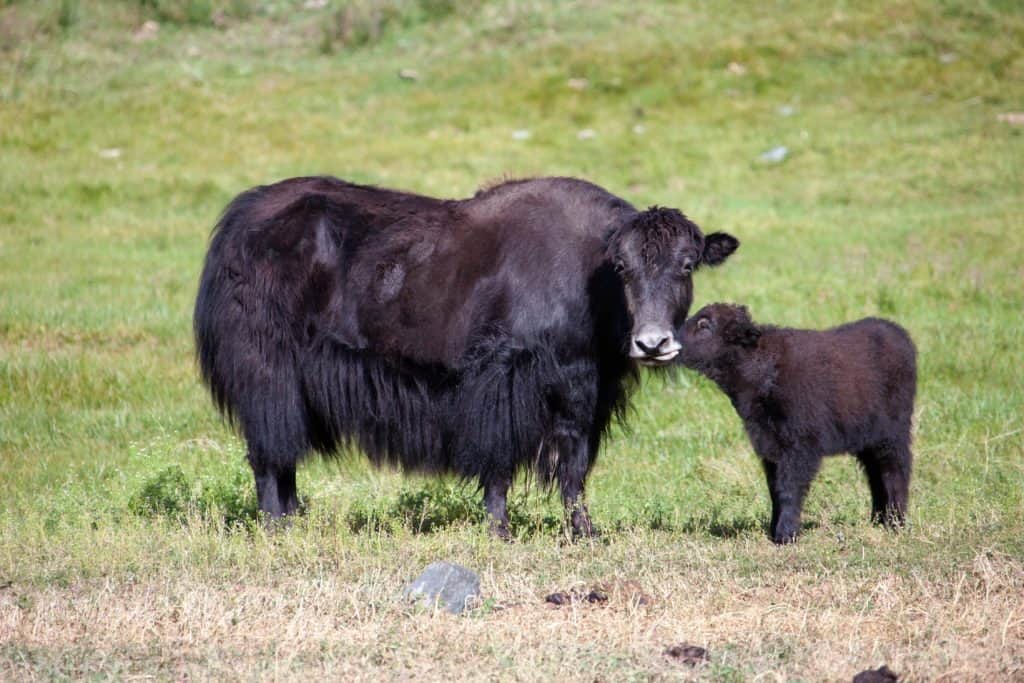
Wild yaks tend to be a deep brown to black, while domesticated ones can be rusty and creamy in color.
©Okyela/Shutterstock.com
Wild yaks tend to be deep, blackish-to-brown in color, but domesticated yaks might have various areas of rust-like browns and creams. The Tibetan wolf is the most known predator of wild yaks; however, snow leopards and brown bears have also been known to prey on them in certain areas. Wild yaks with golden coats are called Wild Golden Yaks, and it is estimated that only 170 of them still exist.
4. They Can Be Trained

Yaks are popular as domesticated companions.
©Michail_Vorobyev/Shutterstock.com
Because of their friendly nature and ease of training, yaks are a popular companion animal. There has been little proof of yak aggression toward humans, even though yak mothers can be quite protective of their kids and even charge when they feel threatened.
5. Males Are More Aggressive During Mating Season

Yaks mate from July through September
©Balachandran Chandrasekharan, CC BY-SA 3.0, via Wikimedia Commons – License
Yaks mate from July through September. Males get angry and will physically fight one another during the rutting season. Males lower their heads and clash horns as they charge at one another.
6. Yaks Are Built For Higher Altitudes
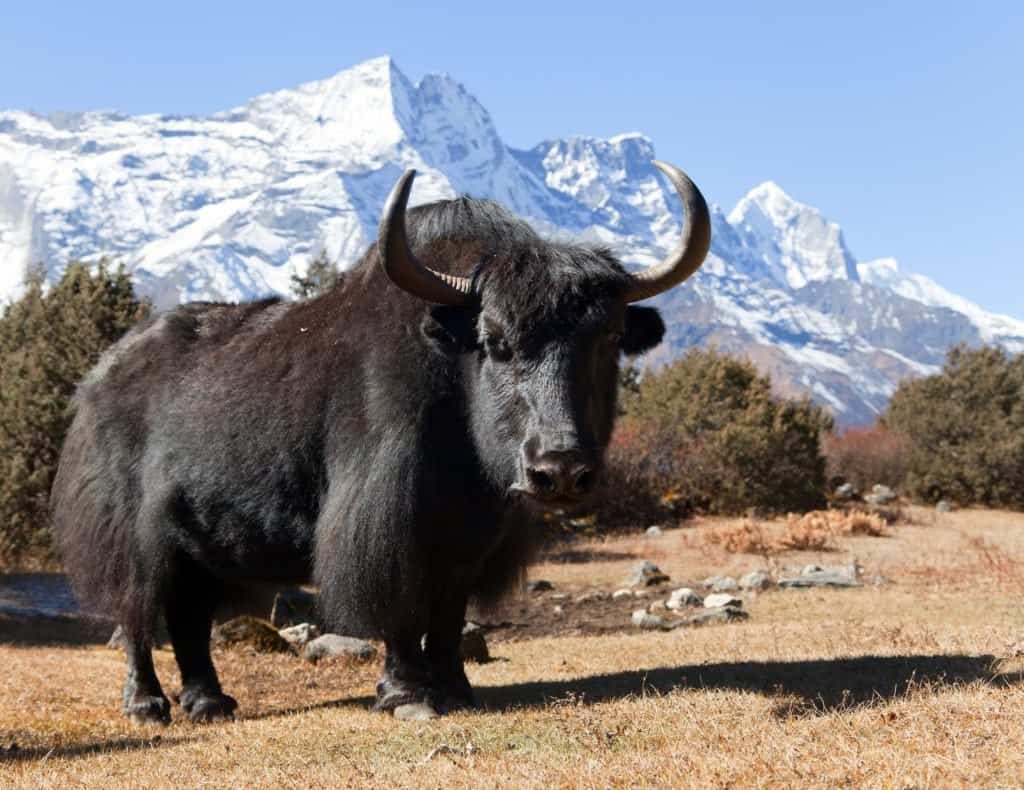
Yaks are built for high altitudes.
©Daniel Prudek/Shutterstock.com
Because of their evolutionary response to life at higher altitudes, yaks have larger lungs and hearts than cattle, making them more efficient at pumping oxygen through their blood. There is no temperature too cold for a yak to withstand in the wild, even if it’s winter. Heat exhaustion sets in at around 59 °F for yaks, making them uncomfortable at lower altitudes. Local farmers, merchants, mountaineering, and trekking excursions employ yaks to transport goods through the Himalayas’ treacherous mountain routes.
7. They Don’t Mind The Cold Weather
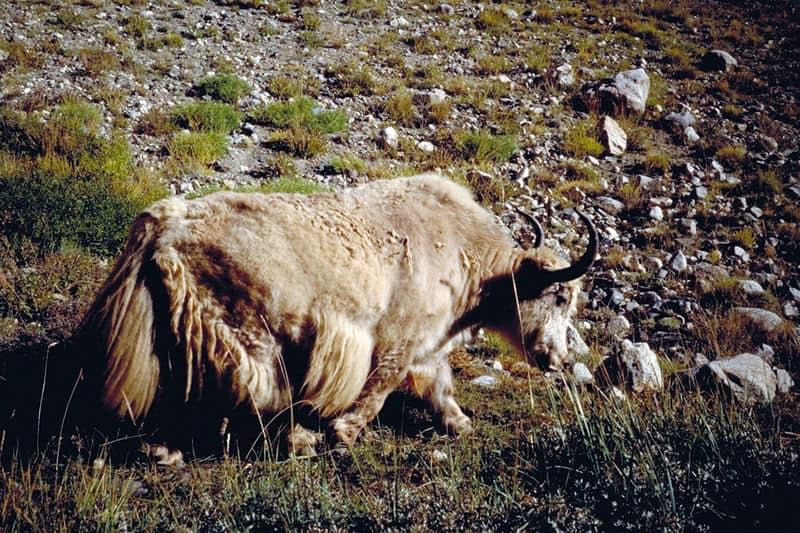
Unlike any other large wild bovid, yaks’ long, shaggy under hair hangs down underneath the belly and, in many cases, reaches the ground.
Long, shaggy hair protects both sexes’ chests, flanks, and thighs, coated in a thick wool undercoat. In males, this can cause a “skirt” to form so long it touches the floor.
Even during the freezing winters, yaks have been spotted dipping in rivers and lakes to warm up.
This is because the yak’s coat provides insulation on two levels: the exterior, a longer layer, and the inside, matted, shorter fur. Unlike any other large wild bovid, yaks’ long, shaggy under hair hangs down underneath the belly and, in many cases, reaches the ground.
8. Their Sweat Is Used In Traditional Nepalese Medicine
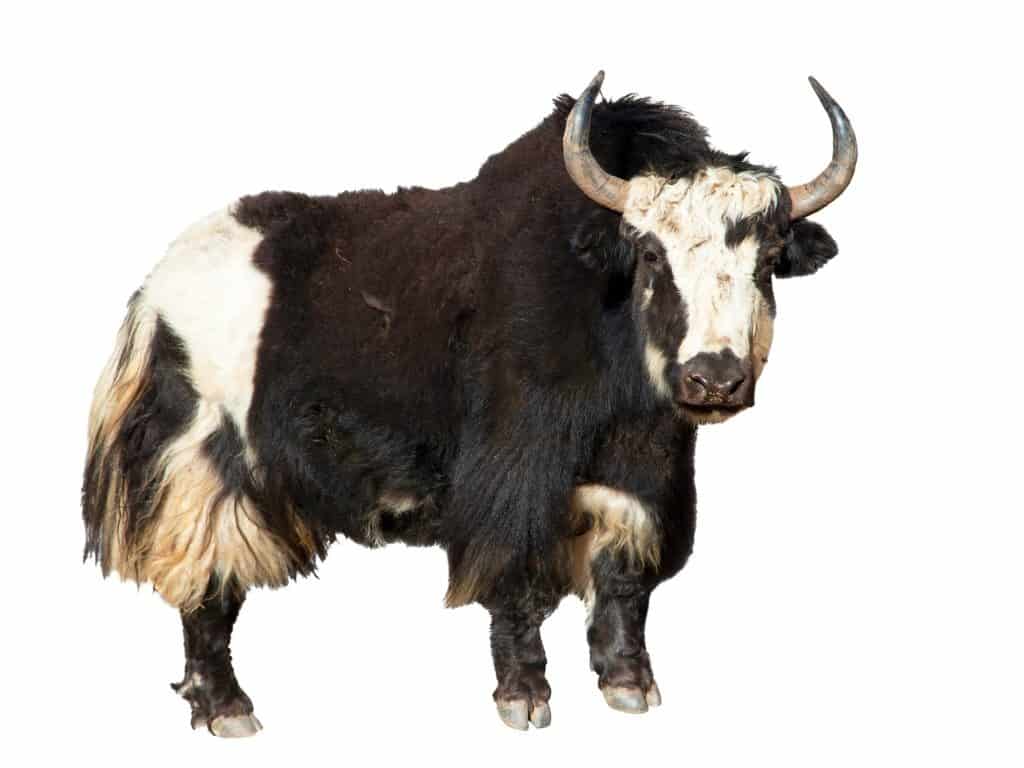
Yaks have substantial fat layers that keep them warm
©Daniel Prudek/Shutterstock.com
A substantial layer of subcutaneous fat covers yaks. They produce a unique, sticky sweat that keeps their under-hair matted and provides additional insulation. The traditional medicine of Nepal uses this secretion.
9. Both Male and Female Yaks Have Horns

Male Yaks have large horns that can measure up to 39 inches long
©Pongratz, CC BY-SA 3.0, via Wikimedia Commons – License
Yaks have short necks and a noticeable hump over their shoulders, especially in males. Their distinguishing features are small ears, a broad forehead, and smooth horns. They are used to break through snow to reach plants buried beneath it.
Males have horns that normally measure 19 to 39 inches in length, sweep out from the sides of the head, and then curve forward. Females have shorter horns ranging from 11 to 25 inches and have an upright form.
10. Yaks Have Been Used In Many Ways
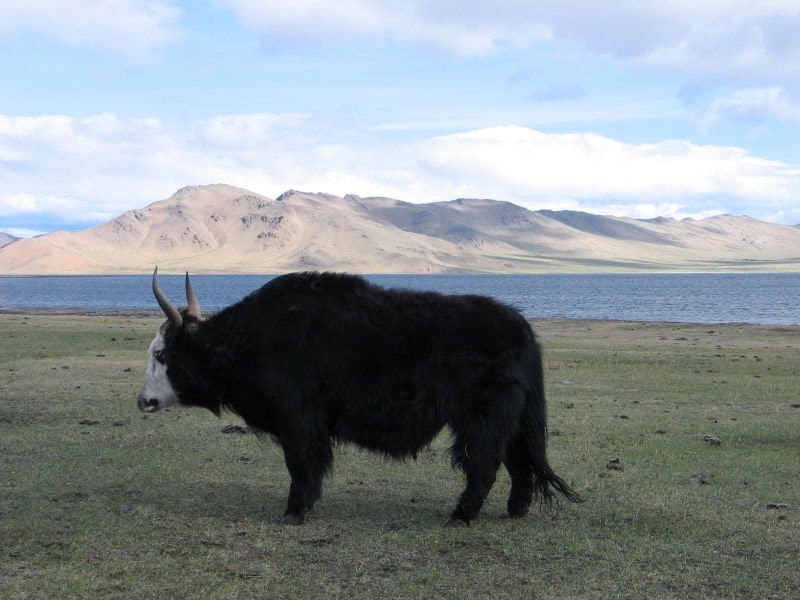
Yaks have long tails like a horse.
©He-ba-mue, CC BY-SA 2.5, via Wikimedia Commons – License
The tail is lengthy and horse-like rather than tufted like that of a cow or a bison. Fake beards crafted from rough yak tail hair are common accessories for Chinese opera singers. Domesticated yaks have served as pack animals, provided textiles and clothing, and fed humans for thousands of years.
Dried yak dung is often the only fuel source on the vast, treeless Tibetan Plateau. Throughout Tibet, it is used as a vital fuel source. Yak milk is cultured in a leather bag to make “milk wine,” which is distilled after fermentation. It is also commonly turned into cheese which is healthier for your heart than cheese produced from dairy animals.
Butter tea, popular in Tibet, is made from yak butter and used as a cooking oil and fuel for lights. In the local culture, yak bone is often used to make decorative buttons, jewelry, and combs. Yak bone is commonly used to create combs, buttons, and other decorative items.
Related Animals:
The photo featured at the top of this post is © SakSa/Shutterstock.com
Thank you for reading! Have some feedback for us? Contact the AZ Animals editorial team.




